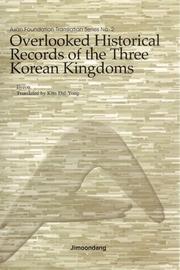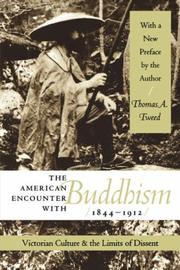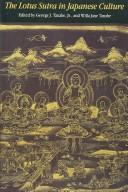| Listing 1 - 8 of 8 |
Sort by
|
Book
ISBN: 9789004693166 Year: 2024 Publisher: Leiden ; Boston : Brill,
Abstract | Keywords | Export | Availability | Bookmark
 Loading...
Loading...Choose an application
- Reference Manager
- EndNote
- RefWorks (Direct export to RefWorks)
"This book provides a comprehensive but concise introduction to Chinese Buddhism and the study of Buddhism in China: their Indic roots, their Sinicization, the development and philosophies of the three central lineages, the natural exchange between Buddhist cultures and schools of thought, the foundations of Buddhist studies in China, and the chief schools and sects in Chinese Buddhism as well as their characteristics and ethos"--
Buddhism --- History. --- Civilization, Buddhist. --- China --- Civilization --- Buddhist influences. --- Buddhist civilization.
Book
ISBN: 085117034X Year: 1973 Publisher: London : Temple Smith,
Abstract | Keywords | Export | Availability | Bookmark
 Loading...
Loading...Choose an application
- Reference Manager
- EndNote
- RefWorks (Direct export to RefWorks)
Slavery --- Slave trade --- Esclavage --- History. --- Histoire --- Buddhism --- Buddhist civilization. --- Civilization, Buddhist. --- Slave-trade --- History
Book
ISBN: 0140218947 9780140218947 Year: 1976 Publisher: Harmondsworth: Penguin books,
Abstract | Keywords | Export | Availability | Bookmark
 Loading...
Loading...Choose an application
- Reference Manager
- EndNote
- RefWorks (Direct export to RefWorks)
Buddhism --- -Buddhism --- -Civilization, Buddhist --- #GGSB: Wereldgodsdiensten --- #GGSB: Boeddhisme --- #GGSB: Oosterse religie --- #GGSB: Oosterse filosofie --- #GGSB: Spiritualiteit --- Buddha and Buddhism --- Lamaism --- Ris-med (Lamaism) --- Religions --- Civilization, Buddhist --- Civilization, Oriental --- Buddhist civilization --- History --- Boeddhisme --- Oosterse filosofie --- Oosterse religie --- Spiritualiteit --- Wereldgodsdiensten --- Buddhist civilization - India - History --- Buddhist civilization - Sri Lanka - History

ISBN: 8988095944 9788988095942 Year: 2006 Volume: 2 Publisher: Seoul, Korea: Jimoondang,
Abstract | Keywords | Export | Availability | Bookmark
 Loading...
Loading...Choose an application
- Reference Manager
- EndNote
- RefWorks (Direct export to RefWorks)
"The book considers the great quantity of Buddhist narratives, anecdotes on primitive beliefs, and folktales, explores the religious consciousness of the Korean people ... The author also attempts to examine Buddhism's influence on Korean culture"--p. 4 of cover
Buddhism --- Legends, Buddhist --- History --- Korea --- Civilization --- Buddhist influences --- K9144 --- Korea: History -- Three kingdoms period (313-935) --- Buddhism - Korea - History - To 935 --- Buddhism - Korea - History - 935-1392 --- Legends, Buddhist - Korea --- Korea - Civilization - Buddhist influences

ISBN: 0807849065 9780807849064 Year: 2000 Publisher: Chapel Hill: University of North Carolina press,
Abstract | Keywords | Export | Availability | Bookmark
 Loading...
Loading...Choose an application
- Reference Manager
- EndNote
- RefWorks (Direct export to RefWorks)
Buddhism --- History. --- Study and teaching --- United States --- Intellectual life --- Civilization --- Buddhist influences. --- Buddhism - United States - History. --- Buddhism - Study and teaching - United States - History. --- United States - Intellectual life - 1865-1918. --- United States - Civilization - Buddhist influences.
Book
ISBN: 7208012326 Year: 1991 Publisher: 上海 上海人民出版社
Abstract | Keywords | Export | Availability | Bookmark
 Loading...
Loading...Choose an application
- Reference Manager
- EndNote
- RefWorks (Direct export to RefWorks)
S13A/0310 --- S37/0200 --- S37/0650 --- China: Religion--Buddhism: China --- Buddhism outside China, Tibet, Mongolia and Japan--General works --- Buddhism outside China, Tibet, Mongolia and Japan--Buddhist theory and study --- Buddhist civilization. --- Buddhist influences. --- Buddhist civilization --- Civilization, Buddhist --- Buddhism --- Civilization, Oriental --- China --- Civilization
Book
ISBN: 9782204095839 2204095834 2492861066 Year: 2011 Volume: 5 Publisher: Paris: Cerf,
Abstract | Keywords | Export | Availability | Bookmark
 Loading...
Loading...Choose an application
- Reference Manager
- EndNote
- RefWorks (Direct export to RefWorks)
La présence de la femme est capitale dans la civilisation bouddhique du sud et du sud-est de l’Asie (principalement ici en Birmanie et en Thaïlande), tant dans les textes fondateurs que dans la pratique quotidienne. L’un de ses aspects les plus fascinants est certainement le rôle des nonnes et, plus généralement, des femmes célibataires. À partir de ce constat, Steven Collins propose une série d’analyses et de réflexions qui feront découvrir au lecteur français un monde très différent de celui auquel l’a habitué la civilisation occidentale : monde dans lequel la religion ne cesse de se construire et où l’on voit émerger, y compris ces toutes dernières années, des figures qui acquièrent pratiquement une stature de déesses - vedettes de cinéma converties ou directrices d’établissements monastiques. Ces femmes sont l’objet d’une vénération étonnante et ont dans la société un rôle aussi important que, dans d’autres contextes, une Mère Teresa ou une Soeur Emmanuelle, quelle que soit la controverse autour du rétablissement de l’ordre monastique pour les femmes. Une autre ligne directrice est l’interrogation sur les privilèges dont jouissent ascétisme et chasteté dans les civilisations traditionnelles, et pas seulement dans le bouddhisme : en rupture avec des systèmes qui mettent au premier plan des valeurs visant à l’enrichissement, à une production intensive et à la jouissance immédiate, l’ascétisme fait pourtant l’objet d’une valorisation très consensuelle. Le point de vue est celui de l’anthropologue et du sociologue. Il permet de nous livrer non seulement une contribution passionnante à l’histoire religieuse du monde contemporain mais également l’une des rares études de genre, Gender Studies, dont nous puissions disposer en français, à travers l’analyse de la définition du sexe/genre dans la pensée bouddhique.
Women --- Women in Buddhism --- Celibacy --- Buddhist civilization --- Religious aspects --- Buddhism --- Buddhist civilization. --- 294.3 --- Civilization, Buddhist --- Civilization, Oriental --- Clerical celibacy --- Clergy --- Sexual abstinence --- Woman (Buddhism) --- Buddhism. --- Boeddhisme--(algemeen) --- Gender studies --- Secularism --- Asia --- 294.3 Boeddhisme--(algemeen) --- 294.3 Boeddhisme:--verder in te delen zoals 291.1/.8 --- Boeddhisme:--verder in te delen zoals 291.1/.8 --- Human females --- Wimmin --- Woman --- Womon --- Womyn --- Females --- Human beings --- Femininity --- Religious aspects&delete& --- Women - Religious aspects - Buddhism --- Women in Buddhism - South Asia --- Women in Buddhism - Southeast Asia --- Celibacy - Buddhism --- bouddhisme --- Asie --- étude de genre --- femmes célibataires

ISBN: 0824811984 9780824811983 Year: 1989 Publisher: Honolulu University of Hawaii press
Abstract | Keywords | Export | Availability | Bookmark
 Loading...
Loading...Choose an application
- Reference Manager
- EndNote
- RefWorks (Direct export to RefWorks)
Arguably the most important document in Japanese Buddhism, the "Lotus Sutra" has had so pervasive an influence that it might be said that no area of Japanese culture has been left untouched by it. This volume is the first attempt in a Western language to look at the sutra's cultural significance from a multidisciplinary perspective. Japanese and North American scholars of history, religion, art, and literature examine how doctrine and worship, meaning and ritual, ideology and power, didactics and aesthetics, have been intertwined in the sutra's long and fascinating history. The book begins with essays by Shioiri Ryōdō and Tamura Yoshirō that summarize the traditional understanding of the content of the sutra and the traditional methods used in analyzing it as a religious document. The essays by Paul Groner, Neil McMullin, and Kuroda Toshio examine how the scripture came to be used by the priesthood both as a buttress in sectarian arguments and as a means to capture political power. The sutra's influence on the arts is the concern of Miya Tsugio, who delineates the various images used to convey the messages of the text in pictorial art, and Yamada Shōzen, who demonstrates its role as the inspiration for numerous poems and as a basis for differentiating poetic style. Allan G Grapard, in his chapter on the "Lotus Sutra" in Kunisaki, reveals the text's applications in the interpretation of physical space and landscape. The final two essays by George J. Tanabe, Jr., and Helen Hardacre discuss the sutra's continuing influence on twentieth-century religious leaders and the new religions of Japan.
Tripiṭaka. --- Criticism, interpretation, etc. --- Congresses. --- Japan --- Civilization --- Buddhist influences --- J1821.20 --- J1865 --- Tripitaka. Sūtrapitaka. Saddharmapundarīkasūtra --- -Japan --- Japan: Religion -- Buddhism -- scriptures -- sutra -- Lotus sutra (Hokekyō) --- Japan: Religion -- Buddhism -- relation with society --- -Congresses. --- -Buddhist influences --- Tripiṭaka. --- Bonbun hokekyō --- Cheng fa hua ching --- Chʻŏm myopŏp yŏnhwagyŏng --- Chʻŏmpʻum myopŏp yŏnhwagyŏng --- Chŏng pŏphwagyŏng --- Dam paʼi chos padma dkar po las mos paʼi leʼu --- Fa hua ching --- Lotus de la bonne loi --- Lotus Sutra --- Miao fa lian hua jing --- Miao fa lien hua ching --- Myobŏp yŏnhwagyŏng --- Pophwagyŏng --- Saddharma-pundarîka --- Saddharmapuṇḍarīka --- Saddharmapuṇdarīka-sūtram --- Sūtra del Loto --- Tʻien pʻin miao fa lien hua ching --- Nihon --- Nippon --- Iapōnia --- Zhāpān --- I︠A︡ponii︠a︡ --- Yapan --- Japon --- Japão --- Japam --- Mư̄ang Yīpun --- Prathēt Yīpun --- Yīpun --- Jih-pen --- Riben --- Government of Japan --- 日本 --- 日本国 --- Nipponkoku --- Nippon-koku --- Nihonkoku --- Nihon-koku --- State of Japan --- Япония --- Japani --- اليابان --- al-Yābān --- يابان --- Yābān --- Japonsko --- Giappone --- Japonia --- Japonya --- Tripitaka. Sutrapitaka. Saddharmapundarikasutra --- Criticism, interpretation, etc --- Congresses --- Sūtra du Lotus --- Japan - Civilization - Buddhist influence - Congresses --- Jepun --- Yapon --- Yapon Ulus --- I︠A︡pon --- Япон --- I︠A︡pon Uls --- Япон Улс
| Listing 1 - 8 of 8 |
Sort by
|

 Search
Search Feedback
Feedback About UniCat
About UniCat  Help
Help News
News